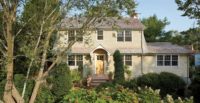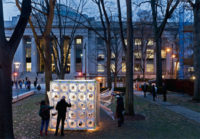Connecticut
A house is not a museum. And the clients for a 3,000-square-foot weekend retreat in Connecticut clearly knew that. While they are involved in the art world, they did not want their country home to be a gallery-like setting for art. Yet it was the Jewish Museum in Berlin, completed in 1998 by Daniel Libeskind, that spurred them to turn to the architect with this residential commission. Like many visitors to the museum, they had observed that its tilting walls, the angular ceilings, and slanted floors heightened the kinesthetic as well as the visual experience of walking through its spaces.
The clients wanted a house that would have these experiential qualities, as well as provide a place where they could relax, read, cook, and take in the landscape. Libeskind, who is not known for creating cozy cabins in the woods, wondered if the latter meant gem'tlich. One of the owners recalls challenging him: 'Whatever you design, we'll ask you to make it more extreme.' Libeskind said yes, and did not even ask for a contract.
The couple had found a rolling 54-acre site in Connecticut dotted with large oak trees and crumbling fieldstone walls left from the 18th century.The architect's radical interpretation of a weekend getaway turned out to be a stainless steel'paneled house that perches on a grassy knoll like a Russian Constructivist bird: its 18 folds yield 36 knifelike points and 54 lines (both folds and edges) following a mathematical series that guided Libeskind and gave the house its name.
As you approach the front door concealed within burnished steel angles, you could be entering a cottage in the 1920 German Expressionist film The Cabinet of Dr. Caligari, whose convoluted sets were designed by Hermann Warm. But this is for real. The soign' elegance imparted by its materials and design make your next reaction all the more surprising: It is cozy. 'You need that in a house,' says Libeskind.
The underneath surface of the stainless steel roof is clad in oak ' dark, warm, comforting oak. Once inside, a ramp gradually draws you down to the living area and the fireplace around which a built-in sofa zigzags. Libeskind designed all built-in furniture, which includes a dining table, banquettes, and numerous fittings, although the clients salted in a few items, such as George III side chairs and traditional lamps, for a bit of contrast.
Owing to the manipulation of the section and plan, private corners and recesses commingle with the open spaces, and glazed openings give on to expansive, but framed and sheltered, views of the landscape. No curtains or shades block your vision. This 'interstitial glass,' in Libeskind's words, was inserted between the folds of the roof. Only one perpendicular wall ' behind the kitchen area ' stands as an offering to a Euclidean pragmatism. Even the fireplace was tucked into the slanted wall, a remarkable event considering that the clients had forgotten to mention it in the program. (The basement level is more straightforward, and includes a yoga room, storage, and a guest bedroom with a fold-down bed.)
The bronze, stainless steel panels cladding the exterior change in the tones and hues from dark copper to purple to dark brown depending on the position of the observer and the time of day, as do the panels' alternation from a shimmering reflectiveness to a matte opacity.
The stainless steel elements are mounted on plywood structural insulated panels (SIPs), with the entirety supported on a steel frame consisting of four angular arches. On the inside, the oak panels are attached to metal studs mounted on the steel frame. Where they extend outdoors, a different finish compensates for the climatic conditions. (The few interior walls not clad in oak are surfaced in Swedish putty.)
In order to keep the rainwater from discoloring the steel panels, gutters follow the low edges of the roof, and downspouts are embedded within the walls. A radiant system in the concrete floor heats and cools the house, although supplementary forced air can be turned on when desired.
All the technical spaces of the house create a handcrafted object that astonishes with its presence, which Libeskind wanted to be 'aggressive and soothing.' While the custom artifact needs cleaning ' much like a boat ' the clients have got a radically experimental cozy cottage in which to live and entertain. They also got one of Libeskind's best works.
PeopleOwner: Private
Architect Daniel Libeskind, FAIA Arne Emerson, principal
David Stockwell – Associate, Design
Interior designer
Engineer(s)
M/E/P:
Consultant(s)
Lighting:
Other:
General contractor
Photographer
Renderer(s) Gross square footage: 3,027 sq.ft. Ground Floor and Basement (unfinished) Completion date: July 2010 |
Products
Structural system
Structural Insulated Panels (SIP):
Exterior cladding
Wood:
Windows
Doors
Hardware Security devices: Supplied by ESCC, NYC Cabinet hardware: ER Butler, NYC
Interior finishes Paneling: Oak Paneling, walls and ceilings, provided by CNR Group. Special surfacing: Concrete floor finish,Vermont Eco-Floors, VT Carpet: Rush Matting provided by Rush Matters, UK
Furnishings
Tables: Upholstery: Houston Upholstery, NYC
Lighting Downlights: RSA Architectural Lighting Task lighting: RSA Architectural Lighting Exterior: Hydrel – An Acuity Brands Co. Controls: Lutron Radio RA 2
Plumbing |
















Post a comment to this article
Report Abusive Comment